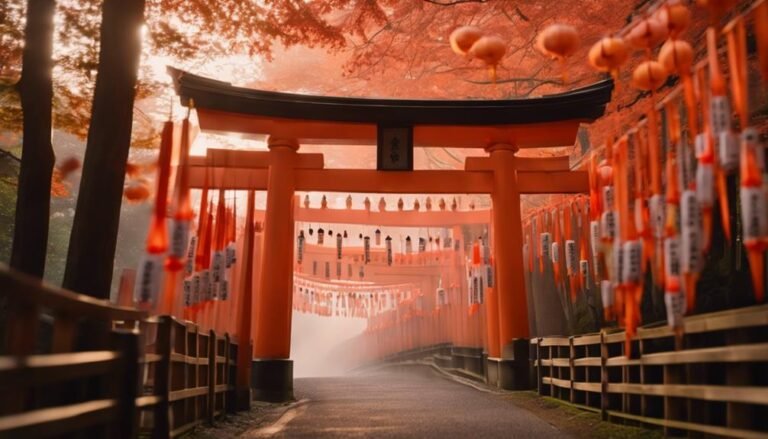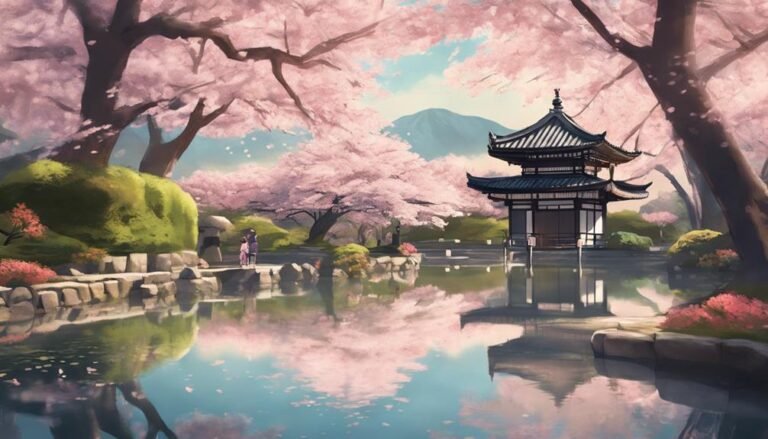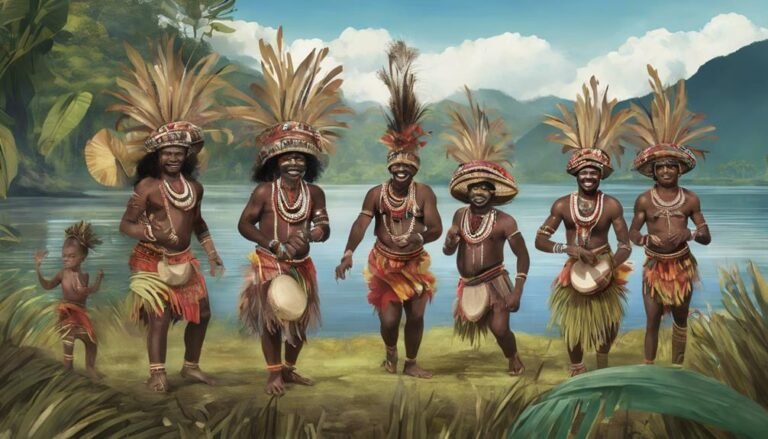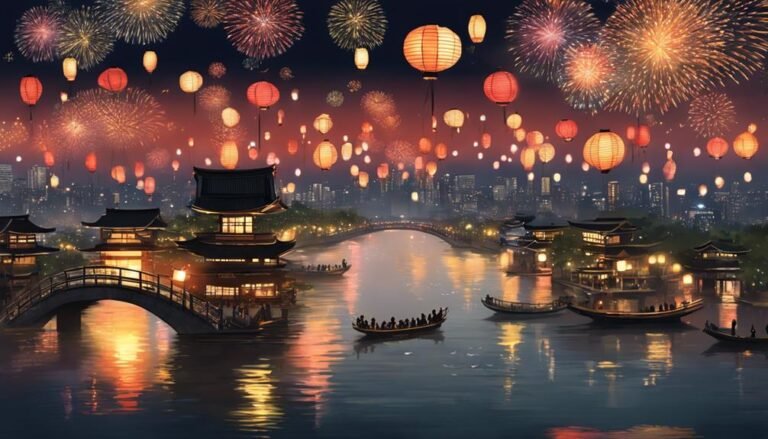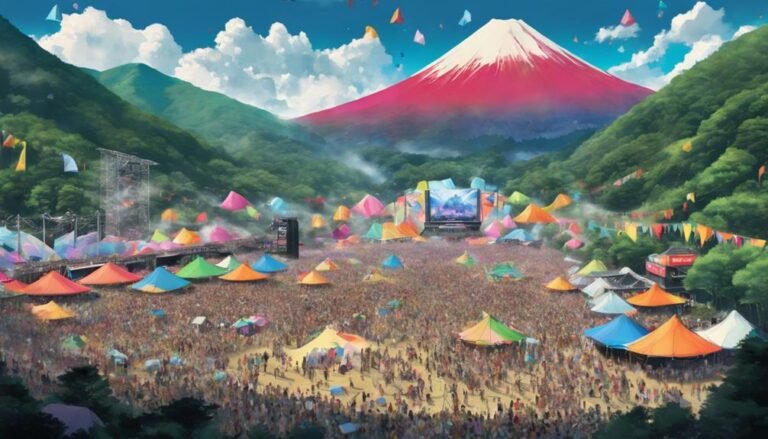Awa Odori Tokushima
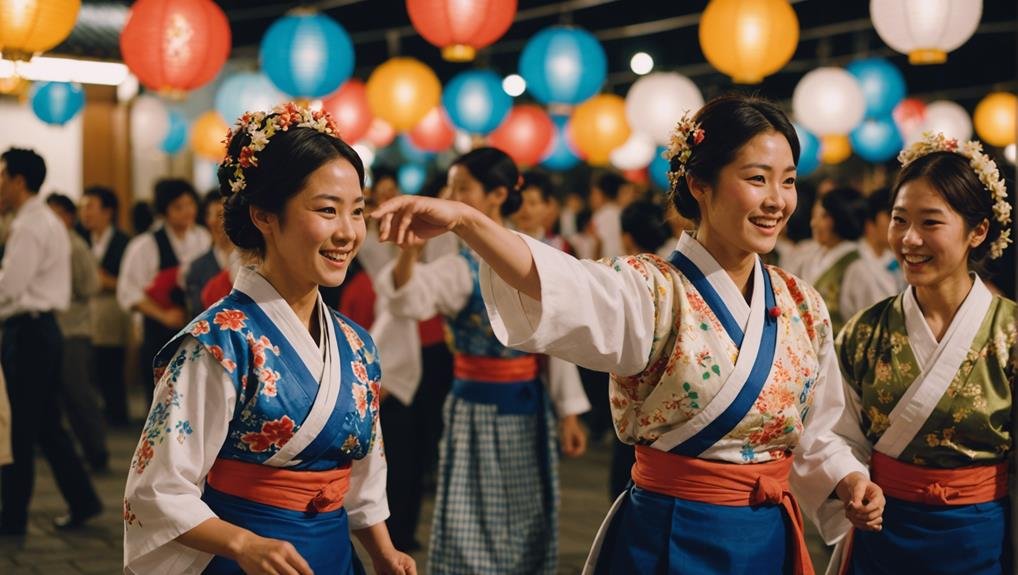
Step into the captivating realm of Awa Odori Tokushima, where vibrant traditional dances have captivated audiences for over 400 years. Ren groups perform mesmerizing dances, showcasing cultural heritage and unity. Feel the energy of the daytime Nagashi dance and nighttime Zomeki performances. Immerse yourself in the harmonious blend of grace and vigor in the dance movements, symbolizing unity and joy. Adorned in traditional happi and yukata, dancers move to the rhythmic cadence of Japanese musical instruments. Experience the cultural significance and historical roots of this festival. Awa Odori Tokushima promises an unforgettable cultural journey.
Key Takeaways
- Awa Odori is a culturally rich and vibrant festival in Tokushima, Japan.
- The festival features traditional dances passed down through generations.
- Awa Odori has deep cultural roots dating back over 400 years.
- Tickets for the festival range from 1,000 to 15,000 yen.
- Transportation options include trains, buses, and flights for easy access to Tokushima.
Festival Overview
Let's explore the vibrant and culturally rich festival overview of Awa Odori in Tokushima, Japan. The Awa Odori festival is deeply rooted in tradition and holds significant cultural importance in Japan. With its festive atmosphere and dynamic community participation, the festival traditions come alive through the lively dances and traditional music that fill the streets of Tokushima.
This annual event, dating back over 400 years, attracts millions of visitors to witness the mesmerizing performances by various dance groups known as ren. These groups, hailing from Tokushima, other parts of Japan, and even overseas, add to the diverse and inclusive nature of the festival.
The cultural significance of Awa Odori lies in its ability to bring people together, transcending boundaries of age, gender, and nationality. The festival not only showcases the rich heritage of Japan but also serves as a platform for cultural exchange and celebration. As you immerse yourself in the vibrant energy of Awa Odori, you can feel the sense of unity and joy that permeates through the community, making it a truly unforgettable experience.
Traditional Dances and Performances
The heart of the Awa Odori festival in Tokushima beats to the rhythm of traditional dances and enchanting performances that have been passed down through generations, showcasing a vibrant display of cultural heritage and artistic expression. The dancers, adorned in colorful happi and yukata, move gracefully to the tunes of traditional music played on instruments like shamisen and drums, creating a mesmerizing spectacle that captivates spectators.
These dances hold immense cultural significance, symbolizing the region's rich history and traditions. While the essence of the Awa Odori remains consistent, there are subtle regional variations in dance styles and performances. Different groups, or ren, bring their unique flair to the festival, incorporating their own interpretations into the choreography. This diversity adds depth to the overall experience, offering a glimpse into the multifaceted world of Awa Odori beyond Tokushima.
Whether it's the daytime Nagashi dance or the nighttime Zomeki, each performance showcases the beauty and complexity of this ancient art form.
Ticketing Details
Tickets for the Awa Odori festival in Tokushima offer various options and price ranges for attendees to choose from. Ticket availability spans different categories, with paid stage areas ranging from 1,000 to 15,000 yen. These tickets can be conveniently purchased through Ticket Pia or 7-Eleven stores nationwide.
For those who prefer last-minute plans, same-day tickets are available for an additional fee of 300 yen, providing flexibility for spontaneous festival-goers. If you wish to experience the daytime performances inside Awagin Hall, tickets are priced between 2,800 and 4,500 yen.
Additionally, festival performance tickets typically go on sale around July, allowing you to plan and secure your attendance early. To streamline the process, consider exploring online reservations and sales options, which can offer a hassle-free way to secure your spot and ensure a smooth entry into the vibrant world of Awa Odori in Tokushima.
Accommodation Options
Considering the high demand for accommodations during the Awa Odori festival in Tokushima, early booking is highly recommended to secure a place to stay. Hotels in Tokushima tend to book out months in advance, given the influx of visitors.
However, if you find it challenging to secure a room in Tokushima, nearby cities like Naruto, Takamatsu, or Osaka offer alternative options. Guesthouses and ryokans are also available in these neighboring cities, providing a more traditional and cultural accommodation experience.
While staying in a nearby city, commuting options like trains or expressway buses can easily transport you to Tokushima for the festival. This way, you can enjoy the convenience of accommodation in less crowded areas while still being able to immerse yourself in the vibrant atmosphere of the Awa Odori festival in Tokushima.
Don't forget to plan your stay and transportation early to guarantee a smooth and enjoyable festival experience.
Transportation Guide
When planning your trip, take into account these travel tips for a smooth journey. If you're coming from Tokyo or Osaka, taking the train is a popular choice. A train ticket from Tokyo costs around 19,000 yen and may take 5-6 hours, but the Japan Rail Pass can cover the journey, although some trains may require a supplement fee.
Alternatively, overnight buses operate between Tokyo and Tokushima for a different commuting option. If you prefer flying, JAL and ANA offer direct flights to Tokushima Airport from Tokyo, Fukuoka, and Sapporo.
When traveling for the Awa Odori festival, it's essential to contemplate these commuting options to find the most convenient and suitable mode of transportation for your journey to Tokushima.
History of Awa Dance Festival
Let's explore the rich history of the Awa Dance Festival, tracing its origins to Japanese Buddhist priestly dances and its evolution from the Bon Odori tradition during the Bon Festival.
The festival has existed as an independent dance party since 1586, with its historical significance evidenced by Tokushima-han feudal administration edicts.
The Awa Dance Festival experienced a revival in the Shōwa period under the Tokushima Prefectural authorities, solidifying its place as a cultural cornerstone in Japan.
Festival Origins
With a history dating back 400 years, the Awa Dance Festival, known as Awa Odori, has deep cultural roots and origins tied to Japanese Buddhist priestly dances and the Bon Odori tradition.
There are three main theories on the festival's origins:
- One theory suggests Awa Odori is a local variation of Bon-odori, a traditional dance honoring the spirits of ancestors.
- Another theory proposes that the festival originated from the completion of Tokushima Castle, celebrating the castle's construction.
- The third theory connects Awa Odori to furyu dance and Japanese Noh plays, indicating a blend of various traditional dance forms.
Awa Odori has historical roots dating back to the 16th century, evolving into its unique style and significance over time.
The festival's origins reflect a fusion of religious, cultural, and historical elements, shaping Awa Odori into the vibrant and iconic dance celebration it's today.
Dance Evolution
The evolution of the Awa Dance Festival, also known as Awa Odori, showcases a transformation deeply rooted in historical and cultural influences. The festival's dance styles and performers have evolved over centuries, drawing from diverse influences and traditions.
Three main evolution theories contribute to the understanding of Awa Odori's development. The first theory suggests a connection to a local variation of Bon-odori, while the second theory links its origins to the completion of Tokushima Castle. Finally, the third theory proposes a connection to furyu dance and Japanese Noh plays.
These evolution theories highlight the complex and multifaceted history of Awa Odori, underscoring its cultural significance and enduring legacy. As the festival continues to thrive and attract millions of visitors annually, the evolution of Awa Odori reflects a rich mosaic of tradition, innovation, and community celebration that has stood the test of time.
Elements of Awa Dance
Originating from Japanese Buddhist priestly dances, the Awa Dance Festival showcases a blend of traditional elements that have evolved over centuries, making it a unique and culturally significant event in Japan.
When exploring the elements of Awa Dance, one can observe the following:
- Dance Movements: The dance movements in Awa Odori are a mix of graceful gestures and energetic footwork, reflecting a harmonious balance between tradition and celebration.
- Cultural Significance: Awa Dance holds immense cultural importance, symbolizing unity, joy, and community spirit among participants and spectators alike.
- Traditional Costumes: Dancers don happi and yukata, traditional attire that adds to the visual splendor and historical context of the performances.
- Musical Accompaniment: The dance procession is accompanied by traditional Japanese musical instruments, enhancing the rhythmic cadence and overall ambiance of the festival.
- Chants and Songs: Chants like Ayattosa and the melodic Awa Yoshikono song play an important role in encouraging dancers and maintaining the lively tempo of the dance.
Dance Styles and Participants
Participants in the Awa Dance Festival showcase distinctive dance styles unique to their respective roles and age groups. The festival exhibits a diverse range of participants, from children to adults, each bringing their charm to the performances.
Women's dances are characterized by graceful yet controlled movements, influenced by the traditional kimono attire. In contrast, children and adolescents often partake in the energetic men's dance, incorporating dynamic movements suited to their youthful vigor.
Dance techniques vary between the daytime Nagashi and the nighttime Zomeki performances, offering spectators a contrasting visual experience. Larger groups may even feature a kite dance known as yakko odori, adding an element of grandeur to the festivities.
The Awa Dance Festival celebrates not only the rich history of the region but also the versatility and creativity of its participants, showcasing a blend of tradition and innovation in their enchanting performances.
Awa Dance Festivals Worldwide
Explore the vibrant world of Awa Dance beyond Tokushima, with festivals celebrated globally that highlight this traditional art form.
From the Koenji Awa Dance Festival in Tokyo, featuring a plethora of dancers and groups, to international events like the Awa Odori version in Paris, the reach of this cultural phenomenon extends far beyond its Japanese roots.
These festivals not only showcase the beauty and energy of Awa Dance but also serve as platforms for cultural exchange and appreciation worldwide.
Global Awa Dance Events
Numerous Awa Dance festivals are celebrated worldwide, showcasing the vibrant tradition beyond its roots in Tokushima, Japan.
- Awa Dance events promote cultural exchange by bringing together dancers from diverse backgrounds.
- These festivals are global celebrations of Japanese heritage and traditional dance.
- Participants learn and share the unique movements and music of Awa Odori.
- The events often feature workshops, performances, and exhibitions to immerse attendees in the Awa Dance culture.
- Through these global Awa Dance festivals, the spirit of community, joy, and tradition transcends borders, fostering connections and appreciation for this lively art form.
International Awa Festivals
The global spread of Awa Dance festivals highlights the vibrant appeal and cultural significance of this traditional art form originating from Tokushima, Japan. These festivals serve as platforms for cultural exchange, fostering connections between diverse communities worldwide.
International participation in Awa Dance festivals showcases the universal language of music and dance, transcending borders and uniting people in celebration.
Awa Dance Festivals beyond Tokushima, such as the Koenji Awa Dance Festival in Tokyo, demonstrate the enduring popularity of this ancient tradition. With an average of 188 groups and 12,000 dancers participating, the Koenji festival exemplifies the global reach of Awa Odori. Tokyo Story's adaptation of Awa Odori in Paris in 2015 further underscores the international appeal and recognition of this vibrant dance form.
Through these international Awa Dance festivals, participants and spectators alike engage in a cultural exchange that celebrates diversity and fosters a sense of unity through the shared joy of dance and music.
Awa Dance in Pop Culture
Awa Dance has made its mark in popular culture through its appearances in various forms of media, including movies, anime series, and even festival posters. The vibrant and energetic movements of Awa Odori have captivated audiences worldwide, showcasing the rich cultural heritage of Japan in an engaging and dynamic way. Here are some ways in which Awa Dance has influenced pop culture:
- Movies: Films like 'Awa dance' and 'Bizan' have featured Awa Odori, bringing this traditional dance to the big screen.
- Anime Influences: Awa Dance has been prominently showcased in anime series like 'Golden Time', integrating traditional Japanese dance elements into modern storytelling.
- Cultural Fusion: The Studio Ghibli film 'Pom Poko' references Awa Odori, highlighting the fusion of traditional dance with contemporary animation.
- Festival Posters: Annual festival posters featuring anime characters practicing Awa dance not only promote the event but also blend traditional dance with modern pop culture aesthetics.
- Media Presence: Awa dance has permeated various forms of media and entertainment, contributing to its enduring popularity and recognition in the cultural landscape.
Frequently Asked Questions
What Is the Significance of the Chants During Awa Odori Performances?
During Awa Odori performances, the rhythmic chants hold profound cultural significance. These chants, intertwined with the dance, enhance the traditional experience, fostering a sense of unity and history. They serve as an essential element of this vibrant cultural tradition.
Are There Any Opportunities for Audience Participation in the Dance?
For audience participation in the dance, consider joining dance workshops for a hands-on experience. Interactive performances encourage crowd engagement, fostering community involvement. Get involved in the lively spirit of Awa Odori through these immersive opportunities.
How Has Modern Technology Influenced the Presentation of Awa Odori?
You've seen how modern technology enhances Awa Odori! Virtual performances and digital choreography revolutionize the presentation, blending tradition with innovation. Experience the vibrant dance festival like never before, thanks to these exciting advancements.
Are There Any Special Rituals or Ceremonies Associated With the Festival?
For festive celebrations, immerse yourself in cultural traditions at Awa Odori. Witness intricate rituals and ceremonies that honor centuries-old practices. Experience the vibrant energy as dancers captivate audiences with their traditional performances.
How Do Dancers Prepare for the Physically Demanding Awa Odori Performances?
To prepare for the physically demanding Awa Odori performances, dancers undergo rigorous dance training to build physical stamina. They practice intricate movements, endurance exercises, and coordination drills to perfect their skills for the festival.
Conclusion
Immerse yourself in the vibrant energy and rich history of Awa Odori in Tokushima, Japan. With mesmerizing performances, traditional dances, and over 4.2 million visitors, this festival is truly a cultural extravaganza like no other.
Don your happi and join the festivities to experience the heart and soul of Awa Odori.
Don't miss out on this celebration of tradition and unity that has solidified Awa Odori's status as the best of Japan's dance festivals.


